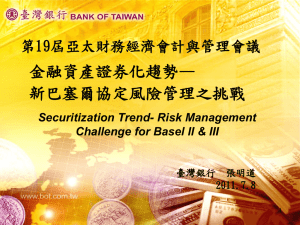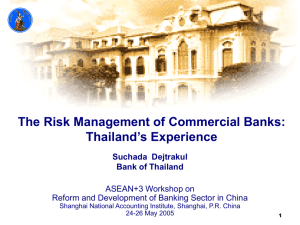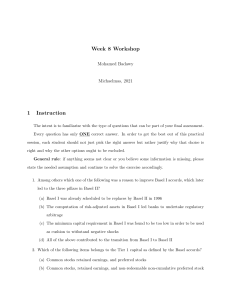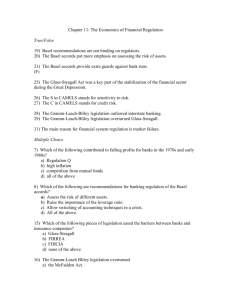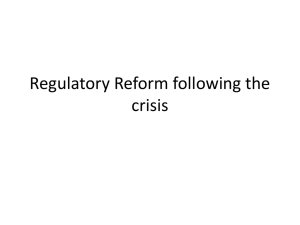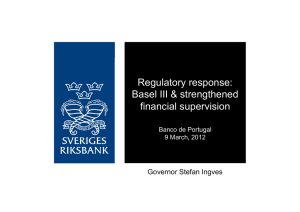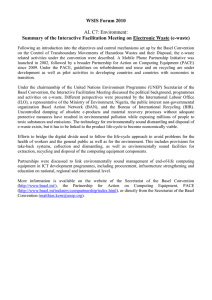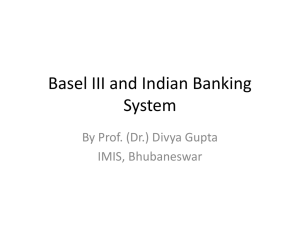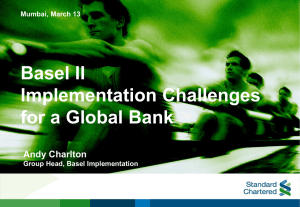Alan McCarthy, Consultant, Eurofin Group
advertisement
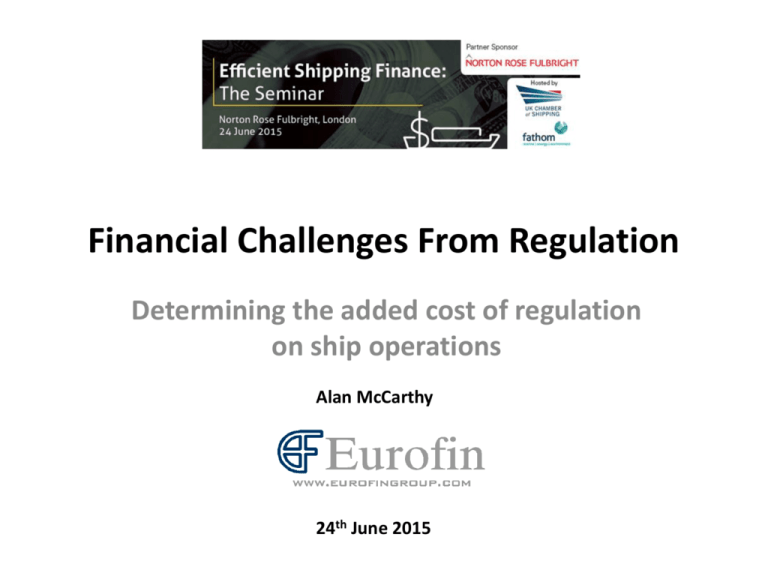
Financial Challenges From Regulation Determining the added cost of regulation on ship operations Alan McCarthy 24th June 2015 Regulations, Regulations…… “Regulations grow at the same rate as weeds” Norman Ralph Augustine, Chairman of the Review of United States Human Space Flight Plans Committee “If you have ten thousand regulations you destroy all respect for the law” Winston Churchill “The problem is that agencies sometimes lose sight of common sense as they create regulations” Fred Thompson, Chairman of the International Security Advisory Board at the United States Department of State “Regulations about environments are going to get tougher and tougher” Carlos Ghosn, Chairman and CEO, Renault Clean Air FLEET Clean Marine Wartsila Closed Loop Scrubber System • US legislation requires the ballast water treatment system (BWTS) to be type approved by the USCG. Currently, no BWTS has such type approval. • USCG published the first list of 9 accepted “IMO” type-approved BWTS as Alternative Management Systems (“AMS”) – May be used for up to 5 years Constant Improvement and Upgrading of Regulations For Example: We Have Had: • STCW; Standards of Training, Certification and Watchkeeping • MARPOL; International Convention for the Prevention of Pollution from Ships We Will Have: • ECDIS; Electronic Chart Display and Information Systems • Unified Requirements; On Containership Design and Construction Cost of Compliance is one thing; Cost of non-Compliance is another What About Financial Regulation? A ‘regulation’, less well known outside of the financial markets that has had, and will continue to have a significant effect on loan capital costs That has arisen as a result of various financial crises: • Asian debt crisis of the late 1990’s, and • The Global Credit Crisis of 2008, post Lehman Brothers BASEL II and its offspring BASEL III How has it come about? The requirement for Banks to maintain Capital Ratio of 8% has been around for a long time After the Asian Debt Crisis in the late 1990’s it became apparent that banks had: • Not precisely defined their ‘true’ capital • Not been fully aware of the risks to their capital structure that certain loan and investment structures posed Leading to the development and adoption of Basel II Developed by the Basel Committee on Banking Supervision ‘International Convergence of Capital Measurement and Capital Standards’ BIS II – June 2006 How has it come about? The main pillars of bank capital structure defined by the Bank for International Settlements (BIS) in Basel, Switzerland to ensure that banks had adequate capital to cope with cyclical financial crises Tier 1 Capital was re-defined so that ‘unusual’ capital instruments were not counted. Individual loan assets within defined sectorial classes were to be individually ‘risk weighted’ to assess the level of capital to be applied against it The higher the risk, the more capital to be applied, the greater the cost to the bank – thus the customer How Well Did it Work? BASEL III The Basel II Framework remains in place, but has been tightened with Basel III What it Means for the Shipping Borrower First in the queue for money: • Large Corporations with Consolidated Structure • Independent, consolidated financial statements o Financial strength, liquidity, leverage • Transparency of revenue generation o Time charters • Asset quality o and critical mass • Best in class corporate governance • Country & Political risk • Quality of counter-party risk What it Means for the Shipping Borrower First in the queue for money, (contd): • Resilience to market risk o Requires − more analysis of markets, trends − less exposure to residual value (Exposure at Default) • Rigorous due diligence The Impact • Fewer lenders • Reduced capacity for those that remain active • Concentration on ‘top tier’ borrowers and ‘trophy’ projects • As banks chase limited number of ‘rated’ borrowers, pricing reduces − 300 basis points plus in 2012, now at under 200 bps • But mid-size and smaller cap companies struggle to find loan capital • Flight to Private Equity has been both expensive and transient • Pricing for mid-cap remains stubbornly high – 300 bps and more • New institutions looking for 450 – 500 bps, maybe higher • The cost of money over time (Time Value of Money – TVM) shortens tenors The Impact on Environmental Matters • Bank financing for retrofitting will be difficult o Where financial savings are identified (lower fuel costs) that can be recaptured and used for loan repayment – OK, some banks considering o Emissions controls – some progress o BWTS - ? • Whatever emerges, Banks must still apply BIS risk analysis
